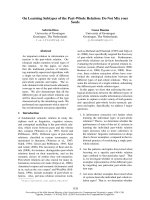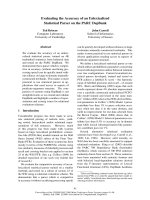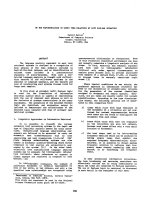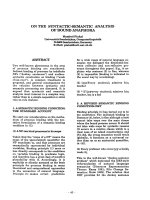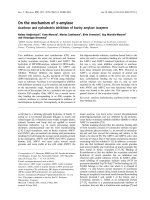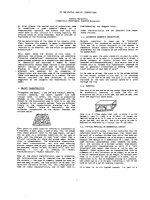Báo cáo khoa học: "On the notion of uniqueness" doc
Bạn đang xem bản rút gọn của tài liệu. Xem và tải ngay bản đầy đủ của tài liệu tại đây (606.74 KB, 7 trang )
On the notion of uniqueness *
Joke Dorrepaal
Onderzoeksinstituut voor Taal en Spraak
3512 JK Utrecht, The Netherlands
Email:
Abstract
In the paper it is argued that for some lin-
guistic phenomena, current discourse repre-
sentation structures are insufficiently fine-
grained, both from the perspective of serv-
ing as representation in NLP and from a
truth conditional perspective. One such
semantic phenomenon is uniqueness. It
is demonstrated that certain elements are
forced to have a unique interpretation, from
a certain point in discourse onwards. This
could be viewed as the semantic counter-
part of surface order. Although it has al-
ways been acknowledged that the left-to-
right order of constituents influences the
meaning of an utterance, it is, for exam-
ple, not reflected in standard Discourse
Representation Theory ([Kamp, 1981]). In
the paper, an alternative representation for
unique constituents will be proposed, re-
sulting in asymmetry of certain conjoined
conditions in a DRS-representation.
Introduction
Logic-based discourse theories are in many respects
not sufficiently fine-grained. This becomes particu-
larly obvious when we consider adopting such a rep-
resentation as an interface in an NLP system.
Suppose we have a discourse as in (1), and assign
it a DRT-like representation as in (2):
*The research reported here was supported by LRE
project 061-62:
Towards a Declarative Theory of Dis.
course
(sponsored by the European Community), and by
Eurotra
(sponsored by the EC and the NBBI).
(1) John owns two talking parrots.
Anne feeds them.
(2) 3z y,z [ John=x & Anne=y ~ parrot(Z) &
Zl=2 & owns(x,Z) & talk(Z) & feed(y,Z) ]
When we take take this representation as a start-
ing point for generation, we end up with at least the
following discourses:
(3) a
b
John owns two talking parrots.
Anne feeds them.
Anne feeds two parrots, which talk.
John owns them.
There are two parrots. They talk.
John owns them and Anne feeds them.
John owns two parrots, which talk.
Anne feeds them.
John owns two parrots that talk.
Anne feeds them.
The multiplicity of solutions in generation from
semantic representations has often led to the conclu-
sion that a purely logical representation is too weak
to guide a generation process. This problem is of-
ten 'solved' by incorporating syntactic knowledge in
the semantic representation, or having the genera-
tion process be guided by more than one source of
knowledge. In many NLP-systems, for example, the
semantic representation reflects the syntactic con-
stituent structure of the string. One could also think
of processing by correspondence (as proposed by [Ka-
plan
et al.,
1989]), using different sources of infor-
mation to guide the task. Below, it will be argued
that these semantic representations are indeed too
weak, but not only from the point of view of Nat-
ural Language Processing. Some linguistic phenom-
ena are not analysed adequately from a truth condi-
tionM perspective either.
106
The phenomenon described in this paper, and ex-
emplified in (3), touches on the notion of restrictive
modification versus non-restrictive modification. I
will demonstrate in what way the analysis of these
cases in DRT-semantics is not adequate. It fails to
assign different representations to discourses that do
differ in truth conditions. The paper will propose an
alternative representation and interpretation for this
phenomenon. The main effect of the proposal is that
the notion of constituent unit is reinstated. This no-
tion is motivated semantically, i.e. on the basis of
truth conditions. The reinstatement of units in the
semantic representation is a first impulse to seman-
tic representations that are strong enough to guide
NLP-processes.
The paper is organized as follows. In section 1,
the problem of uniqueness will be introduced. There
are linguistic means to force uniqueness on the inter-
pretation of a constituent. The prototypical exam-
ple used throughout this paper is the non-restrictive
relative clause. Second, uniqueness comes into play
once we have completed a discourse. Neither dis-
guise of the uniqueness phenomenon is recognized
in DRT. In section 2, two proposals will be intro-
duced which try to remedy these omissions. Section
3 will deal with the distinction between means to
force uniqueness, means to force non-uniqueness and
neutral cases. In section 4, the analysis is presented
and finally, in 5, I will come back to the importance
of the analysis in view of arriving at a more fine-
grained semantic interpretation.
1 Restrictive and Non-Restrlctive
Modification in DRT
In Discourse Representation Theories ([Kamp, 1981;
Kamp and Reyle, 1990; Helm, 1982]) no distinction is
made between restrictive and non-restrictive modifi-
cation. This assumption was challenged in e.g. [Sells,
1985] who argues for a distinction in meaning be-
tween the following minimal pairs:
(4) a Anne owns two parrots, which talk to her)
b Anne owns two parrots that talk to her.
(5) a The talking parrots are happy.
b The
talking
parrots are happy.
The examples in a) concern non-restrictive modi-
fication. Example (4)a makes a claim about all the
parrots that Anne owns: there are two and they talk
to her. She owns no others, talking or non-talking.
In (4)b on the other hand, no such uniqueness claim
is made. She may own other parrots, especially non-
talking ones.
1Note that 'which' can
also be
used in the restric-
tive sense but in this paper, it is reserved for the non-
restrictive reading, to avoid confusion.
If we consider continuations of these sentences as
in (6) and (7), or a linguistic context as in (8), the
distinctions show more clearly:
(6)
a
b
(7) a
b
(8)
a
b
Anne owns two parrots, which talk to her.
• The others
Anne owns two parrots that talk to her.
The others never say a word.
The talking parrots are happy.
• The others
The
~aiking
parrots are happy.
The others look depressed.
Anne owns a lot of parrots.
• She has two parrots, which talk
She has two parrots that talk.
The NPs in the a)-examples should be interpreted
as 'the one and only set X such that all members x
E X ~ Pred(X)', rather than 'there is a set X etc'.
This phenomenon has received much attention in the
literature, and is known as uniqueness ([Heim, 1982;
Kadmon, 1987]), maximality ([Sells, 1985]) or the E-
type effect ([Evans, 1980]).
In DRT, non-restrictive pronouns, restrictive pro-
nouns and ordinary pronominals are all represented
the same. The representation for all the variants in
(9) is (10):
(9) a
b
Anne owns two parrots, which talk.
Anne owns two parrots that talk.
Anne owns two parrots. They talk.
(10) 3~,z [ Anne x & parrot(Z) & [Z[ 2
& own(x,Z) & talk(Z)]
A function verifies the representation in (10) iff
there is a set of two parrots that Anne owns and
that talk. If Anne in fact owns 5 parrots, and 3 of
them talk, all sentences in (9) are equally true in
DRT.
There are two interpretation aspects related to
these examples that DRT does not acknowledge:
First, if we utter sentences like (9) and that's all
we say about those parrots, then most people actu-
ally think that Anne owns two talking parrots, not
seven or hundred. We take this set of two talking
parrots owned by Anne to be unique. Second, in an
example like (9)a, the uniqueness-effect is brought
about even before 'closing the discourse'. The non-
restrictive relative clause has the effect of uniquely
determining two parrots that Anne owns. And all of
these parrots talk.
2
Other Proposals
In the following, two proposals will be discussed that
aim
at (partially) solving the uniqueness problem. In
[Sells, 1985]
non-restrictive and
restrictive pronouns
107
get different interpretations. [Zeevat, to appear] re-
lines DRT-interpretation in another way: certain
parts of the discourse representation are 'closed', the
effect of which is that the reference markers in that
part of the discourse get a unique interpretation.
2.1 Maximality
In [Sells, 1985], it is argued that a distinction needs
to be made between restrictive and non-restrictive
modification. Sells proposes an alternative interpre-
tation for non-restrictive relative pronouns, in which
the pronoun is evaluated with respect to every way
the antecedent was satified.
(11) a John owns some sheep, which graze
(11) b Bz,v,z [ John=x & sheep(Y) &5 owns(x,Y)
& [ Z * Y ] & graze(Z) ]
ill) c
In a DRS K', an extension of a DRS K,
the non-restrictive interpretation
of [ Z * Y ] is:
The function g verifies K' iff
Vf verifying K,
Vale e f(Y) ~ a • g(Z)]
So, for each and every sheep that John owns, it
must hold that the sheep grazes. This contrasts to
a restrictive interpretation, in which case the pro-
noun is evaluated with respect to the one particular
embedding function currently specified for the an-
tecedent.
(12) a
(12) b
(12) c
John owns some sheep that graze
3x,r,z [ John=x 8* sheep(Y) & owus(x,Y)
[Z , Y] graze(Z) ]
In a DRS K,
the restrictive interpretation
of[Z * Y ] is:
The function f verifies K iff
Va [a E f(Y) iff a e f(Z)]
The restrictive interpretation requires that there
be a set of sheep for which it holds that every sheep
in the set grazes and is owned by John. There is
no maximality (or uniqueness) effect with restrictive
modification.
This approach predicts that one cannot utter (13)
when John owns ten sheep, of which only 5 graze:
(13) John owns 5 sheep, which graze
There are ways in which the antecedent is verified
but the anaphoric extension is not. However, note
that, according to this proposal, (13) is a correct ut-
terance in case John owns 10 sheep, and all of them
graze. This prediction will be discussed more exten-
sively in section 2.3.
2.2 Exhaustiveness
In [Zeevat, to appear] the notion of exhaustiveness
(cf. [Groenendijk en Stokhof, 1984]) is used, to ac-
count for the maximality effect. Zeevat expresses ex-
haustification as a condition on truthful embeddings.
(14) A function f embeds a DI~ A exhaustively
iff:
embeds A and Vh =din(A)
f :
h embeds A =~ Vx E din(A) h(x) C f(x) ]
The function f will assign sets of the domain of in-
dividuals to the discourse markers. These sets must
be such that there are no other sets - to be assigned
by any other function h - that have the same prop-
erties but are not contained in the sets assigned by
f.
Take the following examples:
(15) a Bill owns sheep. John shears them.
b There is a doctor in London. He is Polish.
The exhaustive verifying function necessarily picks
the maximal set of sheep Bill Owns (else there would
be other another set chosen by some function h that
would contain the current set). All of these sheep are
sheared by John. Similarly, 'a doctor' in b) necessar-
ily refers to a unique individual who is a doctor in
London. That explains the weirdness of (15)b since
we expect London to have more than one doctor.
2.3 Discussion
In this subsection I would like to summarize some
of the predictions made by the approaches discussed
above.
One major distinction between Sells' approach and
Zeevat's is that Sells 'blames' the anaphor for the
maximality effect whereas in Zeevat's approach, con-
stituents have a unique interpretation by virtue of
their being in focus.
In Sells' theory, the antecedent is evaluated in the
same way as in the original Dl~T-analysis. So, for
a discourse as (16), this means that Anne may have
more than two hikes. Furthermore, Sells claims that
for all of the bikes Anne has - even if she has
15 -
it
must be true that she got them from her brother.
In my opinion, this is not the interpretation of (16).
Indeed, it is possible that Anne has more than two
bikes - bikes we don't care about in this story - but
theses bikes were not necessarily from her brother.
On the contrary, the preferred reading is that they
were not.
(16) Anne has two bikes. She got them from her
brother.
In Zeevat's approach, exhanstification of the an-
tecedent is induced independently of the nature of
the anaphor. If an NP is (in) a focussed constituent,
it is maximized. Let us consider the example that
108
motivated this analysis, (15)b, repeated here.
(15) b There is a doctor in London. He is Polish.
Now suppose I am addressing a friend of mine,
who is Polish and very ill. She's telling me that she
dreads going to a doctor in England, everything be-
ing unfamiliar to her etc. I think in such a situation,
it is completely natural to tell her the following.
(17) There is a doctor in London. He is Polish.
It seems best that you go and see him.
You can talk to him in your own language.
I'm sure he'll understand you.
Summarizing, the idea of exhaustification accounts
for uniqueness by demanding that the verifying em-
bedding is unique. The problem is to explain why it
should uniquely verify the DRS related to the first
sentence in (15)b - to explain the weirdness - but
not so in (16). Sells' maximMity proposal accounted
for uniqueness claims imposed by anaphora, but has
some undesirable empirical consequences.
3 An alternative account
We have discussed two proposals that made an at-
tempt to clarify the uniqueness problem. In one ap-
proach, it is the anaphor that imposes a unique inter-
pretation on the antecedent. In the other, the closing
off of (partial) DRS's causes this effect. Below it will
be claimed that these two ideas should be combined
(and modified) to yield correct results.
I assume that the uniqueness effect stems from two
sources:
• the closed world assumption (implicit)
• linguistic means (explicit)
These assumptions will be discussed in the sections
to follow.
3.1 Closed World
The closed world assumption has the effect that, for a
discourse as a whole, the reference markers are max-
imized. Consider the following paradigm:
(18) I dropped a wine glass
(19) I dropped a wine glass
It was very expensive.
(20) I dropped a wine glass last night.
It was very expensive.
The glass was dear to me,
I inherited it from my grandmother.
last night.
last night.
If someone drops a line as (18), it creates the im-
pression she dropped one and only one wine glass.
If, on the other hand, (19) is uttered, it may be
that she dropped an entire tray of glasses. But,
only one of them was expensive. Similarly, in
(20), the thing that is unique is the x such that
wine_glass(x) & expensive(x) & dear_to_me(x) & in-
herited_fromJny_grandmother(x).
So, this sense of uniqueness is not triggered by
anything in particular in the discourse. It is a side
effect of closing off the discourse.
3.2 Explicit Uniqueness
As Sells has observed correctly, there are linguistic
means to mark uniqueness explicitly. We present
some examples in this subsection.
Nonrestrictive modifiers Uniqueness, or maxi-
mality, is forced by non-restrictive modification, as
can be the case in relative clauses and adjective-noun
phrases.
(21) a
b
(22) a
b
I caught a glimpse of two players, who
were training for the match
(cf. I caught a glimpse of two players
that/who were training for the match)
The aggressive police officers were to
blame for the incident
(cf. The
aggressive
police officers were to
blame for the incident)
In both a) examples, one is forced to conclude that
there is a unique set of people - two players, police
officers respectively - of which all of its members were
involved in the action reported on.
Focusing
Adjuncts
(23) a Only John knew how to behave
b (cf. Even John knew how to behave)
Here, in the a) example, the only x such that x
knew how to behave is John. In b), on the other
hand, it is implied that others knew how to behave,
too.
Structural Focusing
(24) a It was John who gave a present to Mary
b It was to Mary that John gave a present
c It was a present that John gave to Mary
None of the above are logically equivalent. As for
a), John could easily have given presents to girls
other than Mary. This in contrast with b), which
claims that Mary was unique in receiving a present
from John. And vice versa, b) is compatible with
Mary getting presents from other boys, whereas a) is
not. And c) is again different, for similar reasons.
4 The Analysis
4.1 Uniqueness of Discourse
For the closed world assumption, we adopt exhaus-
tiveness for discourses along the line of [Groenendijk
109
en Stokhof, 1984] en [Zeevat, to appear]. Exhausti-
lication applies to the verification of the entire dis-
course, and as such, it is more natural to define the
condition on the function that embeds the discourse
(as in Zeevat) than in the grammar (as in Groe-
nendijk & Stokhof).
(25) The embedding function f uniquely verifies
the DRS K in M iff:
f verifies the conditions in M and
Vh [Vx • rm(K) =¢, h(x) C f(x)]
Note that uniqueness is a property of closed off
discourses (or discourse units).
Let me explain the unique verification in view of
the following examples:
(26) a I spoke to two students yesterday.
They thought the exam was too difficult.
b I spoke to at least two students yesterday.
They thought the exam was too difficult.
If I spoke to exactly two students who thought
the exam was too difficult, a) en b) are both true.
The verifying function maps the reference marker
onto the maximal set of students, 2 in this case.
Both a) and b) are also compatible with the situ-
ation where I spoke to many students during that
day but only two of them thought that the exam
was too difficult. What discriminates a) from b) is
when I spoke to 5 students who reported this com-
plaint about the exam. In a), f maps the reference
marker onto a set of two students who complained
about the exam. There are other sets with the same
properties, though, sets that are not contained in
the set verifyied by f. Discourse b) can in this sce-
nario not be understood as referring to only 2, 3 or
4 students. The embedding function must map the
reference marker onto the maximal set, i.e the set of
5 students.
4.2 Uniqueness of Antecedents
For the analysis of uniqueness forced by linguistic
means, I distinguish three cases:
• marked uniqueness
• marked non-uniqueness
• neutral cases
The a) examples of (21)-(23), and (24)a-c all ex-
plicitly mark uniqueness: (21) by the non-restrictive
clause, (22) by the lack of stress on the modifier, (23)
a focusing adjunct, and (24)a-c, uniqueness is forced
by the clefting construction. Similarly, the b) exam-
ples in (21)-(23) mark non-uniqueness. In (22)b, for
example, the stressed modifier 'aggressive' indicates
that there were non-aggressive police officers - else
we should have uttered (22)a.
Note that this list of linguistic 'tools' to mark
(non)uniqueness is, of course, far from exhaustive.
The point I want to make is that sometimes the con-
text forces a (non)unique interpretation, but in ab-
sence of such explicit indicators, the interpretation
is vague about (non)uniqueness.
The neutral counterparts of (21)-(23) are the fol-
lowing:
(21) c
(22) c
I caught a glimpse of two players.
They were training for the match.
The aggressive police officers were to
blame for the incident 2
(23) c John knew how to behave
(24) d John gave a present to Mary
4.2.1 Neutral interpretation
For the neutral interpretation of pronouns, we
adopt the standard DRT-analysis for anaphora. The
Anaphora Condition below is logically equivalent to
the interpretation of '=' in 'x=y' for anaphora in
DRT.
Given a function 2", and g an extension of f:
3f [ Va • f(X) ~ a • g(Y) ] (Anaphora)
4.2.2 Non-restrictive interpretation
The non-restrictive interpretation is forced when we
add to the anaphora condition that the antecedent
is verified in such a way that there is no other set
that has the same properties and is not a subset of
the set denoted by the antecedent.
3f [ Va • f(X) ¢=~ a • g(Y) ] (Anaphora)
&
Vh [ Va • h(X) a • I(X) ] (Uniqueness)
Note that we need the Uniqueness Condition inde-
pendently for precision adverbs such as 'exactly' in
'exactly 2'.
4.2.3 Restrictive interpretation
The non-uniqueness condition requires that besides
the set that satisfies the antecedent for this contin-
gent function, there is at least another element with
the same properties.
Bf [ Va e f(X) .'. :. a • g(Y) ] (Anaphora)
&
qh [ Ba • h(X) ==¢, a ~ f(X) ] (Non-uniqueness)
2In spoken language, there would be no neutral
form. The stress pattern would always indicate (non)res-
trictivity. In writing, which is what (22)c. refers to, it
usually vague, or ambiguous between the two readings.
110
4.3 ~rther Predictions
First, note that my approach deviates from the tra-
ditional view that non-restrictive pronouns and or-
dinary pronouns should be interpreted equally.
So, the objection against the unique interpretation
in examples like (25) does not hold for the analysis
presented above. Pronouns could indicate unique-
ness but do not so necessarily. (25) is not a coun-
terexample, the pronoun can be used in this non-
unique interpretation.
(25) If a man is in Athens, he is not in Rome
However, if we consider examples where both a
unique and a non-unique interpretation are possi-
ble, the non-restrictive pronoun forces uniqueness,
whereas the ordinary pronoun can be interpreted ei-
ther way.
(26) a
b
If I want to marry a 16-year old, who I
happen to love, then that's my business.
If I want to marry a 16-year old and I
happen to love him, then that's my
business.
The differences are subtle but (26)a seems to be
appropriate only when there actually exists such a
boy the speaker wants to marry or, in other words,
there is a unique candidate in the world. (26)b could
easily be uttered in a situation where there is no
unique boy that fits the description. The discussion
is about the age difference between lovers and (26)b
is uttered not to report on an actual (unique) situa-
tion but to generalize over possible situations.
The analysis also explains why proper names can
never be modified restrictively. After all, a proper
name is mapped unto a unique element from the
start. There is no way that a subset can be taken
from that one element.
a
b
*Yesterday I saw Rambo that I didn't like
Yesterday I saw Rambo, which I didn't
like
Yesterday I saw the Rambo that I didn't
like
Sentence (27)c is correct if there indeed are more
Rambo-movies than the one I didn't like. The re-
strictive clause picks a subset from the set of movies.
A similar argument holds for "generic" uses of
NPs:
(28) a Cats, which are ugly, are not allowed
in my house.
b Cats that are ugly are not allowed
in my house.
When uttering (28)a, I run the risk of offending
all my. cat-loving friends. There is no doubt that I
claim that all cats are ugly animals. It would be
more diplomatic to utter b), where I only talk about
a subset of cats (excluding, of course, my friends'
cats ).
5 Uniqueness and NLP
Let us return to the problem outlined in the introduc-
tion. If we disregard quantificational elements such
as quantifiers, negation etc., a DRT-representation is
just a large set of (unordered) conditions.
(29)
Rm(xl) & Rm(x2) & Pred.(x1) & Predb(x2)
& Pred¢(xl,x2) &: xl=yl & x2=y2 &
Izl=2
& Preda(yl,y2)
• These conditions constrain the assignments of sets
to discourse markers, and the order in which this
happens is without significance (as long as, roughly,
antecedents are introduced before anaphors). I have
shown in this paper that this is an unwanted result.
There are phenomena in language that more or less
indicate that the assignment to a discourse marker
under discussion is fixed at a certain point. This
means that the constraining conditions are not just
interchangeable.
(30) a
b
(31) a
b
The University fired 5 friends of mine,
who were researchers.
The University fired 5 researchers,
who were friends of mine.
I know exactly two Spanish people.
They live in my street.
I know exactly two people in my street.
They're Spanish.
Both the non-restrictive clause and the precision
adverb indicate the properties that exhaust the set
we are talking about. A set consisting of all and only
the Spanish people I know (who happen to live in my
street) is not (necessarily) the same as the set of all
people who live in my street (and who, by the way,
all happen to be Spanish). The asymmetry of these
predications over sets should be represented in the
semantic representation, in order to account for the
difference in truth conditions.
(32) a
b
I have two brothers, who would like to
meet you.
3~,~,z,w [ I=x & you=y & brothers(Z) &
have(x,Z) & Z * W &
would_like_to_meet (W,y)
The interpretation of the arrow is given in section
4.2.2. From that definition it follows that the arrow
is not symmetric. The conditions on the antecedent
and the anaphor are therefore not interchangeable.
This in turn means that we have reintroduced the no-
tion of 'constituent' in our semantic representation.
111
The constituent is not motivated by the full stop, or
any other syntactic or orthographic devices, but for
semantic reasons.
6 Conclusion
In many logic-based discourse theories, the notion
of constituent unit has largely disappeared (disre-
garding quantificational structures for the moment).
These theories do, however, often respect the order in
which constituents appear in the surface string, ac-
knowledging that the left-to-right order of a string is
of importance. This is not reflected in the discourse
representation, though. In this paper, I have shown
in what way exactly this left-to-right order influences
the truth conditions.
When a discourse proceeds, the values to be as-
signed to the reference markers in the discourse are
gradually constrained. If this is the case, then it
makes no difference in which order we constrain the
interpretation: the result will be the same. However,
some linguistic markers fix the interpretation of a dis-
course marker at a certain point. It has been shown
that in these cases, the order of constraints is to be
preserved in order to capture the right truth condi-
tions. In the proposal, unique constituents are anal-
ysed in such a way that they impose an asymmet-
ric relation upon the conjoined conditions of DRS-
formulae. As such, they add more structure to the
discourse representation structures.
Acknowledgements
I would like to thank my colleagues at the OTS for
not getting tired of counting sheep, in particular
Heleen Hoekstra, Louis des Tombe, Andr~ Schenk,
Dirk Heylen en Ren~e Pohlmann. Thanks also to
the participants of the Amsterdam discourse group,
who gave feedback on an earlier version of this pre-
sentation.
References
[Evans, 1980] G. Evans. Pronouns. Linguistic In-
quiry 11, pp 337-362, 1980.
[Groenendijk en Stokhof, 1984] J. Groenendijk en
M. Stokhof. Studies on the Semantics of Ques-
tions and the Pragmatic of Answers. PhD Thesis,
University of Amsterdam, 1984.
[Helm, 1982] I. Heim. The Semantics of Definite and
Indefinite Noun Phrases PhD Thesis, University
of Massachussetts, 1982.
[Kadmon, 1987] N. Kadmon. On unique and non-
unique reference and asymmetric quantification,
PhD Thesis, University of Massachussetts, 1987.
[Kamp, 1981] H. Kamp. A theory of truth
and semantic interpretation. In J.Groenendijk,
J.Janssen and M.Stokhof (eds.), Formal Methods
in the Study of Language,
pp 277-322. Forts Pub-
lications, Dordrecht, 1981.
[Kamp and Iteyle, 1990] H.Kamp and U. Reyle.
From Discourse to Logic, draft distributed at Sum-
merschool Leuven, 1990.
[Kaplan et al., 1989] R. M. Kaplan, K'. Netter, J.
Wedekind, and A. Zaenen. Translation by Struc-
tural Correspondence. In Proceedings of the Fourth
Conference ,of the European Chapter of ~he Asso-
ciation of Computational Linguistics, pp 272-281.
Manchester, 1989.
[Sells, 1985] P. Sells. Restrictive and Non-restrictive
Modification. Report CSLI-85-28, Stanford, 1985.
[Zeevat, to appear] H. Zeevat A theory of Questions
and Exhaustivity. To appear, 1993.
112

